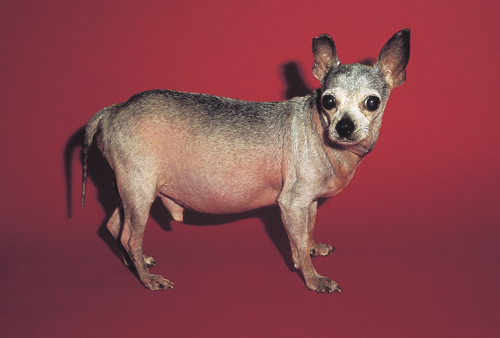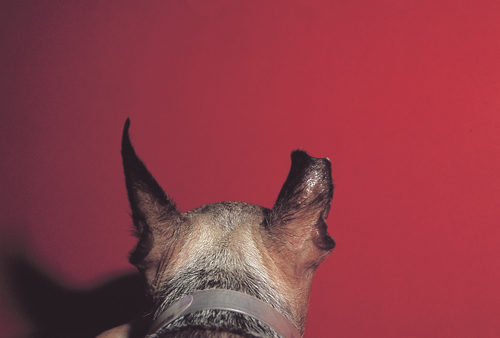Difference between revisions of "Small Animal Dermatology Q&A 15"
Ggaitskell (talk | contribs) (Created page with "{{Template:Manson Moriello}} centre|500px<br>centre|500px <br /> '''A dog was pres...") |
Ggaitskell (talk | contribs) |
||
| (One intermediate revision by the same user not shown) | |||
| Line 11: | Line 11: | ||
|q1=This dog is showing the classic clinical signs of which endocrine disorder? | |q1=This dog is showing the classic clinical signs of which endocrine disorder? | ||
|a1= | |a1= | ||
| − | This dog is showing | + | This dog is showing classic signs of canine hyperadrenocorticism. Note the bilaterally symmetrical hair loss, pendulous abdomen and prepuce, and ‘rat tail’. |
| − | |l1= | + | |l1=Hyperadrenocorticism |
|q2=What are the possible pathophysiologies of ear tip necrosis in this dog? | |q2=What are the possible pathophysiologies of ear tip necrosis in this dog? | ||
|a2= | |a2= | ||
Ear tip necrosis can be seen in cases of canine hyperadrenocorticism, particularly in breeds with small thin ear pinnae. The cause is unknown, but it may be related to micro thromboembolisms. <br><br> | Ear tip necrosis can be seen in cases of canine hyperadrenocorticism, particularly in breeds with small thin ear pinnae. The cause is unknown, but it may be related to micro thromboembolisms. <br><br> | ||
Animals with hyperadrenocorticism bruise easily and the skin becomes thinner, possibly contributing to the development of these lesions. Finally, high concentrations of circulating glucocorticoids may affect healing of the lesions. | Animals with hyperadrenocorticism bruise easily and the skin becomes thinner, possibly contributing to the development of these lesions. Finally, high concentrations of circulating glucocorticoids may affect healing of the lesions. | ||
| − | |l2= | + | |l2=Thromboembolism |
|q3=What other nonendocrine diseases can be characterized by ear tip necrosis? | |q3=What other nonendocrine diseases can be characterized by ear tip necrosis? | ||
|a3= | |a3= | ||
| Line 29: | Line 29: | ||
Feline auricular chondritis is characterized by swollen, erythematous ears that are usually curled and deformed. <br><br> | Feline auricular chondritis is characterized by swollen, erythematous ears that are usually curled and deformed. <br><br> | ||
Familial vasculopathy has been reported in young German shepherd dogs. It is inherited via an autosomal recessive trait, and affected dogs develop alopecia, crusts, and ulceration of the ear tips. Depigmentation and crusting of the footpads may be seen along with lethargy and pyrexia (Ferguson, 2002). | Familial vasculopathy has been reported in young German shepherd dogs. It is inherited via an autosomal recessive trait, and affected dogs develop alopecia, crusts, and ulceration of the ear tips. Depigmentation and crusting of the footpads may be seen along with lethargy and pyrexia (Ferguson, 2002). | ||
| − | |l3= | + | |l3=Vasculitis |
</FlashCard> | </FlashCard> | ||
Latest revision as of 12:28, 7 June 2011
| This question was provided by Manson Publishing as part of the OVAL Project. See more small animal dermatological questions |
A dog was presented for weight gain, hair loss, polyuria, and polydipsia. The owner is also concerned about the loss of the dog’s ear tip. She reports the ear tip bleeds, becomes necrotic, heals, and then the cycle repeats. Physical examination of the ear tip revealed that approximately one-third of the right ear tip has been sloughed as a result of these cycles.
| Question | Answer | Article | |
| This dog is showing the classic clinical signs of which endocrine disorder? | This dog is showing classic signs of canine hyperadrenocorticism. Note the bilaterally symmetrical hair loss, pendulous abdomen and prepuce, and ‘rat tail’. |
Link to Article | |
| What are the possible pathophysiologies of ear tip necrosis in this dog? | Ear tip necrosis can be seen in cases of canine hyperadrenocorticism, particularly in breeds with small thin ear pinnae. The cause is unknown, but it may be related to micro thromboembolisms. |
Link to Article | |
| What other nonendocrine diseases can be characterized by ear tip necrosis? | Other causes of ear tip necrosis include
Feline auricular chondritis is characterized by swollen, erythematous ears that are usually curled and deformed. |
Link to Article | |

